knowing when to say when...
Breaking up is never easy to do. But knowing when to say when to a patchwork project that’s going nowhere is a skill I’m trying to cultivate.
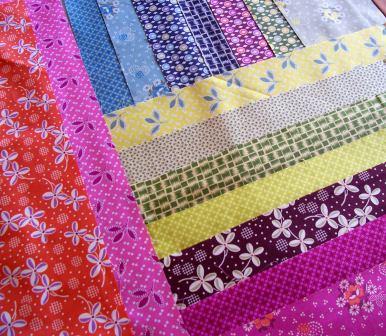 I’ve always felt compelled to finish no matter that I didn’t like what I was working on. To me the very idea of abandoning good fabric is somehow—wrong. It certainly wasn’t the fabrics’ fault that I failed to use it well. I need to—as Tim Gunn might say—make it work. Put it to good use. I need to save it!
I’ve always felt compelled to finish no matter that I didn’t like what I was working on. To me the very idea of abandoning good fabric is somehow—wrong. It certainly wasn’t the fabrics’ fault that I failed to use it well. I need to—as Tim Gunn might say—make it work. Put it to good use. I need to save it!
Back in February Chicago Tribune cultural critic Julia Keller wrote a column about quitting a book that just didn’t engage her—and apparently hit a nerve—because readers responded with over 150 emails describing their own sense of guilt, shame and sense of failure over quitting before getting to the end.
She wrote…”We turn off TV shows without a second thought. We walk out of movies on a whim. Concerts and plays? Sometimes, we don't even wait for intermission. But abandoning a book feels different. It feels shabby and small-minded and short-sighted. Like a character flaw.”
Wow—that hit home. Bad movie—stop, eject and return to Netflix. Bad TV show—like this week’s Master Chef’s conversation about sucking the flesh out of a goat—click and over to HGTV because you just never know when you’ll want to install new tile in the bathroom!
But quitting a quilt top?
Yikes—that’s really hard.
Of course I could rationalize this and say—I’m just taking some time off. I’ll come back to it when I have some perspective. Absence may make the heart grow fonder. It’s not the quilt—it’s me.
But who am I kidding here? When it’s not working, it’s time to move on.
And that’s what I just did this week with my Denyse Schmidt project. I bit the proverbial bullet, cut new fabric from the bolt and started another top with a new pattern. Making the decision to end it was tough—and I can’t say it takes the sting out of feeling like I failed those poor little fabrics. But I am committed to moving on. I’ve got the strip sets sewn and I’m planning to cut the pieces out this weekend. Construction starts next week.
Stay tuned…ccc
washing the quilt....
We get lots of questions, but the number one question is usually—
How do I wash my quilt?
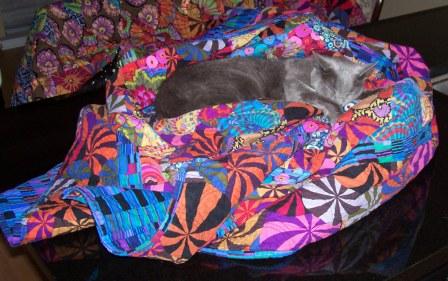 First, let me say there is a world of difference between vintage heirloom quilts and the quilts we’re making today. If you have an old quilt that your great grandmother hand-pieced and hand-quilted—please ignore these instructions. Cleaning that quilt will depend largely on the type of fabrics used and the condition of the piece. If it’s fragile, you might want to consult a local dry cleaner or experienced quilter—someone who can evaluate it and give you specific guidance.
First, let me say there is a world of difference between vintage heirloom quilts and the quilts we’re making today. If you have an old quilt that your great grandmother hand-pieced and hand-quilted—please ignore these instructions. Cleaning that quilt will depend largely on the type of fabrics used and the condition of the piece. If it’s fragile, you might want to consult a local dry cleaner or experienced quilter—someone who can evaluate it and give you specific guidance.
But for those of us who make quilts to be used—basic machine washing is the way to go. What you need to know is that heat is the enemy of fabric. Nothing fades and shrinks cotton fabrics faster than hot water and hot dyers! So I use a gentle detergent or quilt soap in cold to warm water in the machine. Then I toss the quilt into the dryer on a delicate cycle and dry the quilt about half way. After that I pull it out and hang it to air dry the rest of the way.
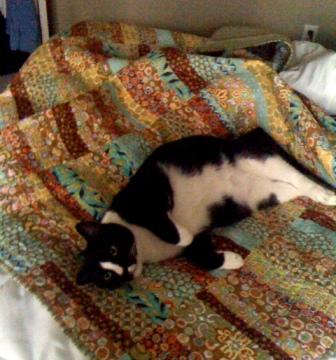 I’ve gifted quilts to people who washed them to death—and yes they have faded—but in the end I know that they’ve been well loved and used. And no, I don’t mind if the cats sleep on them. There’s nothing in this world that my little Miss Molly loves more than a nice warm quilt to curl up in. And since she’s a member of the household too, she’s welcome to it!
I’ve gifted quilts to people who washed them to death—and yes they have faded—but in the end I know that they’ve been well loved and used. And no, I don’t mind if the cats sleep on them. There’s nothing in this world that my little Miss Molly loves more than a nice warm quilt to curl up in. And since she’s a member of the household too, she’s welcome to it!
My niece Tara just completed her Urban Amish throw and reports that Nancho is quite pleased with the result too!
cheers,
going with the sewing flow....
 Sometimes we all go through periods of writer’s block, those periods when the words just don’t come easily to us. I think I’m having one of those periods right now. I’ve been so busy writing product descriptions for my new e-commerce site; I’ve neglected this blog space. So instead of pushing words, I’ve been piecing blocks. Sure, it’s a mindless distraction, but sometimes you just have to go with the sewing flow, let your mind wonder and hope that something really amazing emerges.
Sometimes we all go through periods of writer’s block, those periods when the words just don’t come easily to us. I think I’m having one of those periods right now. I’ve been so busy writing product descriptions for my new e-commerce site; I’ve neglected this blog space. So instead of pushing words, I’ve been piecing blocks. Sure, it’s a mindless distraction, but sometimes you just have to go with the sewing flow, let your mind wonder and hope that something really amazing emerges.
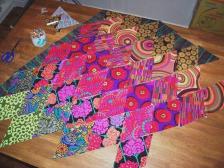
And this got me thinking about a book I read a while back. When Professor Janet Catherine Berlo suffered a severe bout of writers block, she retreated into months of fabric therapy, piecing blocks with reckless abandon, and contemplating life, work and personal relationships. She documents this period of time in a wonderful little book “Quilting Lessons: Notes from the Scrap Bag of a Writer and Quilter.”
Today I think I’ll just post pictures of the works in progress at Quiltology—along with some of Berlo’s wise insights on the nature of quilting and how it relates to our lives.
Enjoy…and cu soon...
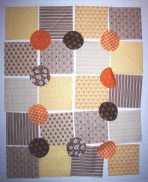
“A good rule of thumb, both in quilt design and in the design for living: a strong, complex, geometric design is achieved by repeated alternations, not simple repetition of the same thing.”
Here's a picture of Kat's new little Baby Spot On quilt she's making in the Thursday night studio class. Kat's focus fabric is Joel Dewberry's new sparrows print. Just wait until you see the fussy cut spots she's created!
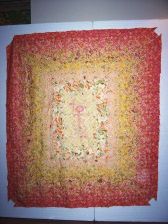
“Like a haiku, a nine-patch is deceptively simple in its structure. It takes rigorous paring down to make it work. Like a haiku, when well done, it achieves a poetic elegance.”
Jill's newest Blooming 9-Patch beauty--this one made from Heather Bailey's Fresh Cut fabrics in shades of peach, yellow and pinks. Another labor of love for Jill's new little niece.
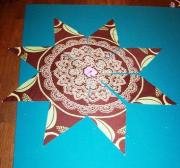
“It is crucial to accept the messiness of the process.”

“It is important to take pleasure in the overall pattern, rather than focusing on the shortcomings of any one square.”
